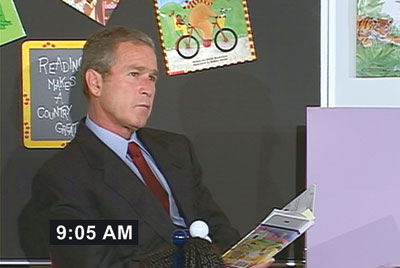EXECUTIVE SHUFFFLE
Sundance 2004’s hits and misses, and the changing distribution landscape for independent film.
BY MARY GLUCKSMAN
 |
| Michael Moore’s Fahrenheit 9/11. |
The docs were better,” is the perennial Sundance one-line, but 2004 was truly the year of the non-fiction film as docs scored significant box-office and critical success in the specialty arena. Fahrenheit 9/11 and Sundance pick-up Super Size Me were, of course, the obvious hits with grosses of $119 million and $11.5 million respectively. But the big news is that the ten next most successful docs totaled $26 million at the domestic b.o.
2004 began with the publication of a much-buzzed Peter Biskind book that bashed Sundance and Miramax with equal fervor and some say was the cause of Bingham Ray’s ouster from UA. By the end of the year Sundance was still standing but Harvey Weinstein had lost almost as much luster as Michael Ovitz, and Miramax appeared to be on life support, Oscar chances for The Aviator and Finding Neverland notwithstanding. Ray, meanwhile, was one of a handful of names rumored to be in contention to top a possible new indie division at Paramount that could run parallel to or replace ever-struggling Paramount Classics while the studio was apparently also considering a bid for Newmarket. UA itself faced an uncertain future with parent MGM sold to Sony, already home to the longest-running indie distribution success story in history, Sony Pictures Classics, plus genre division Screen Gems. Fox Searchlight officially became the new Miramax, Focus Features was dubbed the new Searchlight and Fine Line finally showed signs of life for the first time since parent New Line, itself a Warner division, bet the farm on the Rings trilogy. The year also saw a new specialty division, Warner Independent Pictures, field its first slate of six distinctive films, including Before Sunset, A Home at the End of the World and A Very Long Engagement.
Focus, Fox Searchlight and Sony Classics represent a power base of fiefdoms playing off different strengths that allow them to complement rather than cannibalize each other in the marketplace. But the gulf between these well-financed companies and all the smaller standalones is occupied by a single company: Lions Gate, the company independent enough to release Fahrenheit 9/11. Still struggling to absorb Artisan, Lions Gate continues to execute a smart business model that utilizes cash infusions from genre crowd-pleasers like Saw to offset riskier specialized fare like Dogville.
Among true independents trafficking primarily in American features and foreign films, maybe ten are significant players right now. Of this group only Strand, Zeitgeist and Samuel Goldwyn lack major credit lines or deep-pocketed parent organizations to absorb the vagaries of market fluctuation. The first two companies are 15 years old and still led by their scrappy founder-owners; Samuel Goldwyn, Jr. may be equally scrappy but at 76 he’s been in the business of distributing independent pictures under his famous family name (in a series of incarnations) longer than most readers have been alive. This year, Strand’s more than a dozen films were mostly foreign, while usual world cinema specialist Zeitgeist, riding high on a 2003 Oscar for Nowhere in Africa, was notable for three distinctive docs — The Divan, A Letter to True, and The Corporation — among its six releases. (The latter grossed $1.9 million and became the seventh best doc performer of the year.) Samuel Goldwyn scored twice with docs in partnership with former UTA agent Howard Cohen and producer Eric d’Arbeloff’s new Roadside Attractions. The companies initially teamed to buy Super Size Me at Sundance and later boarded self-distributed metaphysics polemic What the #$*! do We Know? mid-run and guided it to third-best doc box office performance at $9.9 million.
Sense a trend? The doc drama just didn’t quit this year. IFC Films and Magnolia Pictures are both divisions of expansive cable operations. (Magnolia was bought late last year by Todd Wagner and Mark Cuban’s 2929 Entertainment.) Both serve up a mix of edgy U.S. and foreign indies but saw their most notable 2004 box office success with docs. IFC took Touching the Void to the fourth best doc box-office performance at $4.6 million and also captured the ninth spot with Metallica: Some Kind of Monster at $1.2 million while a half-dozen other releases foundered. Following last year’s Capturing the Friedmans triumph, Magnolia took Control Room to $2.6 million (2004’s fifth-best doc box office showing) and rang up a 13th-best $391,950 for Ramones chronicle End of the Century. The company also had a surprise $6.9 million blockbuster when it went after the Passion of the Christ demographic with preacher drama Woman Thou Art Loosed.
“I knew there was an audience for it, and one that doesn’t get many films of this quality,” says Bowles. “That was the first time we stepped up the ladder — we spent a relatively small amount by wide-release standards but it dwarfed our other efforts including Friedmans, which was largely publicity-driven. We’re trying to grow slowly and organically but we now have a completely integrated company with international and video which we’re in the process of defining so we’ll have every link in the chain. We’re not on the scale of the studios but we’ll have a similar system of synergy and integration so we can do worthwhile films where theatrical may not be the ultimate win.”
Passion distributor Newmarket was a for-hire participant in that film’s release with Mel Gibson putting up P&A and the distrib raking in a hefty performance-triggered fee as box office soared to $370 million, surpassed only by Shrek 2 and Spider-Man 2. More typical Newmarket release Monster chalked up $34.5 million and a Best Actress Oscar. The two-year-old distribution arm of financiers Newmarket Entertainment Group (Memento) had four more ‘04 features including the director’s cut of Donnie Darko, Stander, P.S. and Silver City, the latter the high performer of the quartet at only $1 million, though Christmas release The Woodsman could do Monster business and yield awards noms for star Kevin Bacon. Two more mid-sized distributors, ThinkFilm and a ramped-up Wellspring, plus U.K.–based Tartan Films, which recently opened a U.S. division, are releasing a mix of provocative indies, docs and foreign films. That’s a couple dozen potential new slots for hard-to-pigeonhole critic’s darlings. Some of these titles also find a home at Palm Pictures. Theatrical is rarely the primary win for Palm’s releases, but as a stop on the road to DVD release that sector of music mogul Chris Blackwell’s benevolent empire offers niche positioning to eight to ten features a year. Tartan USA’s ten-film ’05 slate includes high-profile items like Gregg Araki’s Toronto fave Mysterious Skin, Michael Winterbottom explicit sex tale 9 Songs, Cannes cult hit Old Boy and Japanese chiller Vital.
Wellspring’s move to player status with films like Tarnation, The Brown Bunny and, in ’05, Todd Solondz’s controversial Palindromes is the latest development for a ten-year-old company whose history rivals Primer for hairpin turns. Bought by WinStar New Media in 1998, merged with venerable home-video purveyor Fox Lorber thereafter and spun off with private financing when WinStar went Chapter 11 in 2001, the company got a four-year, $8 million cash infusion from its February sale to Las Vegas investment group American Vantage Media. Staffed up with the addition of energetic distribution exec Ryan Werner, fresh from stints at Palm and Magnolia, Wellspring released ten films this year and capped ’04 with a qualifying run for Henry Darger portrait In the Realms of the Unreal, its entry on the Best Doc Oscar shortlist. Until now chiefly reliant on revenue from its formidable home entertainment division, company anticipates theatrical growth from a new ability to release films on a 15 to 30 print range rather than the five to ten that have capped its films’ runs to date. With Tarnation still playing out, French thriller Red Lights was Wellspring’s ’04 high grosser at $631,548 while Bunny made $365,984 and foreign narratives Strayed and Seducing Doctor Lewis played in the mid-six-figure range.
A go-to distrib for doc filmmakers since it took Spellbound to $5.7 million and an Oscar nomination last year and infused with new capital this summer, ThinkFilm is blazing a new kind of path to stability and market branding. Eight of the company’s dozen films this year were docs, and year-end releases Born into Brothels and Tell Them Who You Are landed on AMPAS’s 12-film Best Doc Oscar shortlist alongside Story of the Weeping Camel. Rock doc Festival Express, John Kerry portrait Going Upriver and Camel all placed among the ten highest-grossing docs of the year after Fahrenheit 9/11; together, the three films grossed $3.5 million. Think’s other docs were Jonathan Demme’s Haiti story The Agronomist, cautionary tale Overnight and chess portrait Game Over; fiction films included Primer and year-end release The Assassination of Richard Nixon. The company was early to the spiritual pic party with last year’s scripture drama The Gospel of John, which continued to roll out in ‘04 for a final tally of $4 million.
“You don’t always plan how you forge your identity,” says Urman. “We don’t want to focus primarily on documentaries, but the most distinctive films we’ve seen in the last year happen to be documentaries, and we’re able to get them attention, credibility and, in some cases, real box office. Films that are dark and tough are not doing as well as they used to and films about provocation that four or five years back would have been propelled into the mainstream on the basis of ‘edginess’ are not performing. A film like The Brown Bunny in the ’90s would have done over a million.”
Doc or drama, members of the class of Sundance 2004 yielded some of the most impressive box office performances in the fest’s history. The eight films profiled below include all five dramatic competition entries released by mid-October plus a film each from the fest’s doc competition, American Spectrum and Frontier sections. Together they grossed over $120 million.
GARDEN STATE
 |
| PHOTO: K.C. BAILEY. |
THE FILM: Scrubs star Zach Braff’s black comedy about the dark heart of New Jersey’s suburbs is more mainstream than Todd Solondz if not quite the new-millennium Woody Allen its Sundance program note asserts. With Braff starring and Natalie Portman as the love interest, melancholy tale of an L.A. actor dumping his meds on the trip home for his mom’s funeral connects with audiences, but a dismissive Variety review yawns, saying film might “yield mild b.o. returns.”
THE FINANCING: Reported as $2.5 million secured from former mortgage banker Gary Gilbert in his first foray into film after Jersey Films exec Pam Abdy reads the script and signs on to produce with Jersey partners Danny DeVito, Stacey Sher and Michael Shamberg in exec producer slots.
THE DEAL: Film’s first screening in a prime opening day slot is all it takes for Miramax and Fox Searchlight to launch a heated rights fight that culminates 24 hours later in an unprecedented joint deal brokered by attorney Andrew Hurwitz with a reported $5 million worldwide pricetag and each company paying half; Searchlight ends up handling domestic.
THE RELEASE: Fox Searchlight squeezes the last drop out of this one before and after July 28 release in nine theaters. Braff does Letterman, Last Call with Carson Daly, Charlie Rose, Live with Regis and Kelly and The Today Show, and reviews are solid from Roger Ebert to Rolling Stone. Also key is Braff’s Searchlight-sponsored blog. First frame’s $22,346 per screen average is weekend’s highest, and film passes $500,000 in second weekend in 35 theatres and $1.3 million in third weekend in 175. In sixth weekend in high of 813 theatres it passes $15 million.
THE OUTCOME: The final tally: $26.7 million in three months. With 20 foreign territories from the U.K. to Lebanon already on the release sked, a DVD due December 28 and a soundtrack burning up the charts, this State is minting money.
WINNERS & LOSERS: Spirit noms for best first feature and first screenplay and the National Board of Review cites Braff for best directorial debut. Still on Scrubs, he’s due to star in Tony Goldwyn’s romance, The Last Kiss, this spring. He’s already directed an episode of Scrubs and is adapting children’s book Andrew Henry’s Meadow for big Fox.
MARIA FULL OF GRACE
 |
THE FILM: Spanish-language tale about a young Colombian who takes a gig as a drug mule to get to New York City but faces dire consequences. First-time feature filmmaker Joshua Marston may be California-bred but he nails the inflections of this immigrant story; it’s hard not to squirm when the eponymous Maria forces down a series of heroin-packed condoms. Although it’s NYU MFA film grad Marston’s first trip to Sundance, he has three award-winning shorts to his credit. Buzzed as a highbrow item going into the fest, Maria snags the Audience Award and moves on to Berlin, where star Catalina Sandino Moreno ties Charlize Theron (Monster) for Best Actress and Marston gets fest’s Alfred Bauer Award for Best First Feature. That’s just the beginning of an awards bonanza that includes the LAFF’s audience award, Best Actress at Seattle, Best Film and Best Actress in Newport, three awards in Deauville and numerous year-end kudos.
THE FINANCING: An estimated $3.5 million from HBO Films’s indie booster Maude Nadler after a trip to the IFP Market’s No Borders in 2001, Sundance lab development and a Slamdance screenplay award.
THE DEAL: HBO and Fine Line have a joint distribution operation but execs at both companies claim that this pact is for English-language pics only and thus excludes Maria. Nonetheless, Fine Line winds up with the film, a deal which is announced before fest’s end. Sales arm HBO Films London sells a dozen international territories including all of Europe, Japan, Mexico and Israel in following month.
THE RELEASE: Heavy grass-roots marketing to the Colombian community and some of the year’s best reviews kick off Maria’s mid-July release in seven theatres. Per-engagement average of nearly $20,000 is weekend’s highest, a scenario repeated next weekend in same theaters. Third-weekend widening to 65 engagements takes Maria past the million-dollar mark and gradual expansion to 127 theatres takes film to $3 million in six weeks and $5 million in nine.
THE OUTCOME: $6.5 million in 16 weeks.
WINNERS & LOSERS: Colombia selects Maria as its Foreign Language Oscar contender but AMPAS rejects it as insufficiently Colombian to be eligible. Critics’ awards include Best First Film from the New York Film Critics’ Circle, Best Foreign Language from San Francisco, and a New Generation Award from the LA Film Critics Association. Five Spirit noms include best feature, director, first screenplay, actress and supporting actress. Marston and Moreno win Gotham Breakthrough awards and Marston signs with William Morris; he’s completing a sophomore project screenplay set in the American south he’ll reteam with producer Paul Mezey to make. Maria is HBO’s third Sundance winner in as many years after Splendor and pre-Fine Line pact Real Women Have Curves. It’s a huge boost for Fine Line, which later in the year trumps sturdier colleagues by taking Vera Drake and The Sea Within rights before the films’ Venice premieres.
 |
| PHOTO: AARON RUELL. |
THE FILM: Geek-chic comedy about a misfit teen and his out-there friends and family from Brigham Young film student Jared Hess, 24, previously known for his similarly-themed Slamdance 2003 short Peluca. Variety calls this one a “comedy of condescension” and likely example of “the Happy, Texas syndrome — a picture that hits big at Sundance but can’t find its way in the real world.” It’s alternately celebrated and vilified at Sundance depending on viewer age — kids love it but most over 30 fail to see the point.
THE FINANCING: A few hundred thousand from friends and relatives to shoot in Preston, Idaho, where film is set and Hess grew up.
THE DEAL: The film arrives in Park City without much buzz but by the end of its day-two first screening sales rep John Sloss is fielding multiple offers. After the second screening, Searchlight’s Peter Rice goes Harvey on Hess and ends up with worldwide for a reported $3 million. In May Rice announces that Searchlight’s partnering with MTV Films and Paramount on marketing and international distribution.
THE RELEASE: Searchlight hosts 350 pre-release screenings in more than 50 markets in a campaign that generates review-proof word-of-mouth. Heder appears on Letterman, MTV’s TRL and the Today Show. Release is June 11 in six theatres, expanding to 18 and 73, after which third weekend Napoleon banks its first of many millions. For weekend seven widening to 389 engagements, Searchlight adds an epilogue à la 28 Days Later to entice repeat viewers for whom its ocean of freebie tie-ins from T-shirts to lip balm are not enough. Sloss calls Searchlight’s campaign a “hall-of-fame job.” “I’d like to teach it in business school,” he tells Variety.
THE OUTCOME: At $44 million and a high of 1,025 engagements, Napoleon ranks as the 55th highest grosser of the year by Halloween — no small feat for an out-of-nowhere indie.
WINNERS & LOSERS: Two Spirit noms for best first feature and supporting actor Jon Gries. Hess and Heder are signed by UTA and CAA respectively and quickly become icons; there’s talk of a Napoleon TV spinoff. Hess gets a first look deal with Searchlight and animation student Heder graduates from Brigham Young.
OPEN WATER
 |
| PHOTO: LAURA LAU. |
THE FILM: No-budget shark tale shot with real predators, Open Water is based on a scary true story that provides a hook for hungry press. First seen in rough cut at the 2003 Hamptons fest, film surfaces in American Spectrum section at Sundance where public audiences go wild. Film is the second from writer-director-editor Chris Kentis and his producer and wife Laura Lau.
THE FINANCING: About $130,000 from the couple’s savings and Kentis’ day-job cutting trailers. That’s just enough for a digital shoot in the Bahamas and other Caribbean locations over two years with Kentis and Lau manning a pair of DV cameras and editing at home on Final Cut Pro.
THE DEAL: To Lions Gate for a reported $2.5 million for worldwide after a first-night screening feeding frenzy. Filmmakers are repped by veteran acquisitions exec Rona Wallace and attorney Sue Bodine. Lions Gate quickly sells two-dozen international territories for a sum approaching its rights pricetag and stands to profit handsomely from December’s DVD.
THE RELEASE: Lions Gate supports Open Water with a reported $20 million P&A spend; Kentis does Letterman and Kilborn and plenty of print press focuses on the making-of what many call “Jaws lite.” August 6 opening on 47 screens takes film to its first million with a per-screen average of $23,424. Eight more screens next weekend take it to $2.5 million and third weekend widening to high of 2,709 screens puts it just shy of $15 million. Five weeks out the total’s a toothsome $28.2 million.
THE OUTCOME: An easy swim to $30.5 million in eight weeks; by Halloween overseas take adds a further $19 million.
WINNERS & LOSERS: Open Water is shut out of the Spirits but you can bet Kentis and Lau, both now Endeavor clients, won’t be mounting their next project no-budget.
PRIMER
 |
THE FILM: This year’s Grand Jury prize-winner, Dallas-based Shane Carruth’s tantalizing first feature details the unexpected consequences of an experiment in a garage that leads a pair of young engineers and colleagues into a new realm — literally. Going into Sundance, a catalogue note calling the film’s technospeak incomprehensible sounded an ominous note ,but comparisons to π’s spare elegance proved apt, and audiences buzzed all week. Film also won fest’s second Alfred P. Sloan prize for incorporating science into its storyline and went on to a dozen plus regional U.S. fests; its international debut was at Edinburgh in August.
THE FINANCING: Just $7,000 out-of-pocket to get in the can and a quoted $40,000 to the 35mm Sundance print. Carruth is an engineer who taught himself filmmaking, applied his science background to resolving production issues, and cast himself as lead because he already knew the lines. He also edited and wrote the score over a two-year post that followed the five-week ’01 shoot.
THE DEAL: Carruth cold calls mPRm publicist Mark Pogachefsky before the festival and convinces him to screen the film and then pitch it to sales rep Cassian Elwes at William Morris. ThinkFilm’s Mark Urman makes an offer for North America before the awards ceremony but other interest and Carruth’s insistence on weighing the relative merits of a small advance versus maintaining back-end interest stalls a deal until February. Tartan takes U.K. early, and Conquistador shops international, likely a hard sell for this wordy pic though territories set include sci-fi friendly Spain and Portugal.
THE RELEASE: Esquire calls Primer the “headiest” sci-fi film since “2001”, and New York Times critic A.O. Scott classes it with Memento. Think targets physics societies, tech corporations, gaming enthusiasts and genre buffs with screenings and an Internet-driven campaign. Opening October 8 in New York, Dallas and nearby Plano, Texas against Friday Night Lights yields a $7,000 plus average but expansions in following weeks to 19, 29 and 31 theaters produce precipitous declines in averages.
THE OUTCOME: Film struggles to $424,760 in 10 weeks. “There are a lot of territories yet to come — whole tiers of college towns and calendar houses — but the market is extraordinarily congested right now,” said Urman after Thanksgiving. “We’ll let it bubble long enough for people who didn’t see it to think twice, and I think we’ll do $600,000.”
WINNERS AND LOSERS: Carruth will surely get another shot, maybe in the form of financing for the ambitious exotic-location romance he’s still writing. Accolades so far include a Gotham year’s-best-film nom and four Spirit noms including best feature, director, first screenplay and debut performance (for David Sullivan).
 | SUPER SIZE ME
THE FILM: Morgan Spurlock’s great adventure over 30 days on a McDonald’s-only diet. Though Super Size Me is Spurlock’s first feature, the Tisch grad has 12 years’ experience directing TV, ads and music videos. Buzzed going into Sundance by sales rep John Sloss, film’s an instant hit and wins the doc directing award. Two dozen more fests take Super Size Me from San Francisco to San Sebastian with awards at Edinburgh and Full Frame. |
THE FINANCING: Under $75,000 of Spurlock’s own cash.
THE DEAL: Slamming McDonald’s the way it does makes Super Size Me a hot potato for studio-owned distribs whose parents rely on fast food tie-ins to promote their megabudget fare. Tongues also wag about potential lawsuits though fair-use doctrine would appear to obviate any litigation. A week after the fest domestic theatrical and DVD/VHS rights go to a partnership between Samuel Goldwyn Films and Roadside Attractions for a reported mid-six figures. They later sell home video to Hart Sharp Video, the new ancillary arm of the New York production company. A&E buys cable, and Cinetic sells Australia and the UK at Berlin before Fortissimo comes on to handle the rest of international; they ultimately sell the film to 50 territories. In May, Showtime picks up exclusive pay TV rights. Spurlock’s concept for a companion Super Size book engenders a three-way bidding war with G.P. Putnam winning out in May.
THE RELEASE: More press and local TV/radio than you can shake a stick at after a promo tour that takes Spurlock across the country before he winds up on Letterman and The Today Show. Spurlock screens the film for Congress and launches an initiative to put nutrition education and better food choices in schools. Just before the film hits theaters, McDonald’s quietly phases out its supersize option. Super Size Me’s no longer just a film; it’s a movement and Spurlock’s faithful blogging keeps a vocal community of converts up-to-date. May 7 release on 41 screens in nine cities and a second week on 117 screens take the film close to the $2 million mark. It passes $5 million after four weeks, $8 million after six and an expansion to the run’s high of 230 engagements, and hits $10 million during its ninth week out.
THE OUTCOME: At $11.5 million Super Size Me is the fourth highest grossing doc of all time. Variety was off the mark here too — it called Super Size Me “most suitable for TV.”
WINNERS & LOSERS: Spurlock sells a spin-off reality series 30 Days to FX; strand puts subjects in a radically different lifestyle for one month in each episode. A family-friendly Super Size Me DVD (no rectal exam or cussing) suitable for classroom use is due soon.
TARNATION
 |
THE FILM: Jonathan Caouette’s dazzling collage portrait of his life so far, from prepubescent drag impressions of his mom to adult attempts to parse his troubled family’s history. The ride to Sundance begins when Caouette starts logging a lifetime’s footage on Apple’s iMovie in ’03 and shows a section to John Cameron Mitchell. The Hedwig director urges him to rush a feature rough cut for a MIX fest deadline, and the three-hour tape version so moves MIX chief Stephen Winter he comes on as producer. Mitchell and Gus Van Sant both come on as exec producers and Caouette edits the film down to 88 minutes and scores a Sundance Frontier slot. Publicist Mickey Cottrell bombards attending press with accolades that yield a near-exhaustive journo turnout at film’s Egyptian screening. Film is ineligible for Park City awards and screens next in Cannes’ Directors’ Fortnight where it provokes an equally extravagant response. A doc directing prize at the LAFF is followed by slots in Toronto, Chicago and the NYFF.
THE FINANCING: The film’s miniscule budget (Caouette claims to have gotten to the Sundance HD cut for $218.32) is part of its marketing appeal.
THE DEAL: Distribs are squeamish about the film’s large quantity of uncleared music and TV/movie clips — word on the street is that it’s “unreleasable.” Ten weeks after Sundance Wellspring announces a worldwide deal and co-producer position to take film through the clearance process and blow it up to 35mm, a pricetag they later estimate as $400,000. Company helps covers its costs with Cannes sales to the U.K. and Australia followed by pacts for a dozen major territories and a cable sale to the Sundance Channel. Caouette gets back-end participation and an up-front fee.
THE RELEASE: October 6 opening at New York’s Film Forum capitalizes on previous night’s New York Film Festival screening and attendant press. Wide print coverage and rhapsodic reviews boost Tarnation’s single-theater gross to $23,135. A second weekend adding theatres in L.A., San Francisco, Chicago and Cambridge yields a $15,523 average and third week addition of multiple Texas and California spots brings film to its max of 22 screens. Tarnation makes $435,000 in nine weeks with at least 30 new engagements yet to unspool.
THE OUTCOME: “I had hoped it would do better but no matter how glowing the reviews are you can’t get around the fact that it’s difficult material. I think it will come in around $750,000,” says Wellspring distribution head Ryan Werner. “It will be on screens for a long time, and we’re counting on [critics’] top ten lists.”
WINNERS & LOSERS: Tarnation scores Spirit and Gotham noms for best doc, best first feature at the London Film Festival and the Emerging Filmmaker Award from the International Documentary Association. Caouette’s expressed interest in another montage project but may be fielding for-hire offers now that he’s signed with William Morris.
WE DON’T LIVE HERE ANYMORE
 |
| PHOTO: KIMBERLY FRENCH. |
THE FILM: Steamy drama is a Bob and Carol and Ted and Alice for a new generation. With Mark Ruffalo, Naomi Watts, Laura Dern and Peter Krause as the libidinous quartet, title’s a must-see going into Park City. It’s director John Curran’s third trip to the fest after short Down, Rusty, Down (’97) and made-in-Australia debut feature Praise (’99). Screenplay by Larry Gross, 48 Hours scribe who’s always switch-hit between studio fare and indies, is based on two Andre Dubus stories and wins fest’s Waldo Salt award for writing. Foreign fests include Deauville and London.
THE FINANCING: Gross wrote the original script in the late ’60s and wound up with the rights after unsuccessful dalliances with various studios in the intervening 30-odd years. Inspired by the success of Dubus adaptation In the Bedroom, Gross partnered with Front Street Films producer Jonas Goodman, son of Dubus’ editor. With the cast on board Front Street partners secured full financing from their investor pool and approached Curran in early ’03; Vancouver shoot happened fast thereafter to accommodate cast’s common window of availability.
THE DEAL: The film is repped at Sundance by William Morris Independent’s Cassian Elwes and Rena Ronson. Newcomer Warner Independent Pictures (WIP), launched in August ’03, captures North American and U.K. rights for $2 million midfest; they quickly sell the U.K. rights to Redbus Pictures. Foreign sales agent Renaissance Films seals deals for 20 territories at AFM and Cannes.
THE RELEASE: August 13 on seven New York/L.A. screens for a sizzling $14,471 average that falls by half next weekend on 29 screens and 40 percent next weekend on 90 screens. Widest saturation is four weeks out on 90 screens.
THE OUTCOME: $2 million in two months. We Don’t Live Here Anymore is the third release from WIP after Before Sunset ($5 million box office) and A Home at the End of the World ($1 million), and all three underperform.
WINNERS & LOSERS: Maryse Alberti’s cinematography gets film’s single Spirit nom. Curran gets a directing gig on the New Line road-trip drama Five Dollars a Day. WIP has a bumpy first year but could strike gold with Thanksgiving release A Very Long Engagement. With a bold ’05 slate including Douglas McGrath’s Every Word Is True, Liev Schreiber’s Everything is Illuminated, a Richard Linklater Philip K. Dick adaptation A Scanner Darkly and John Maybury’s The Jacket (a Sundance premiere featuring Adrien Brody), the company might yet become one of most influential specialty distributors.
Go to: The 2004 SUNDANCE THEATRICAL BOX OFFICE CHART.
VOD CALENDAR


 See the VOD Calendar →
See the VOD Calendar →


